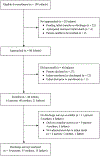Decisional Satisfaction, Regret, and Conflict Among Parents of Infants with Neurologic Conditions
- PMID: 35227757
- PMCID: PMC9232962
- DOI: 10.1016/j.jpeds.2022.02.043
Decisional Satisfaction, Regret, and Conflict Among Parents of Infants with Neurologic Conditions
Abstract
Objective: To characterize decisional satisfaction, regret, and conflict among parents of critically ill infants with neurologic conditions.
Study design: In this prospective cohort study, we enrolled parents of infants with neurologic conditions in the intensive care unit (ICU). Hospital discharge surveys included the validated Family Satisfaction with the ICU (FS-ICU) decision making subscale, Decision Regret Scale (DRS), and Decisional Conflict Scale (DCS). We defined high satisfaction with decision making as an FS-ICU score ≥75, high decisional regret/conflict as DRS/DCS score >25, and within-couple disagreement as a difference of at least 25 points between scores.
Results: We enrolled 61 parents of 40 infants (n = 40 mothers, n = 21 fathers); 35 mothers and 15 fathers completed surveys. Most mothers reported high satisfaction with decision making (27 of 35; 77%) and low decision regret (28 of 35; 80%); 40% (14 of 35) reported high decisional conflict. Mothers and fathers reported higher decisional conflict in the domains of uncertainty and values clarity compared with the domain of effective decision making (Bonferroni-corrected P < .05). There were no differences in decision outcomes between paired mothers and fathers; however, within any given couple, there were numerous instances of disagreement (7 of 15 for decision regret and 5 of 15 for decisional conflict).
Conclusions: Many parents experience decisional conflict even if they ultimately have high satisfaction and low regret, underscoring the need for decision aids targeting uncertainty and values clarity. Couples frequently experience different levels of decisional regret and conflict.
Keywords: critical care; neonatology; neurology.
Copyright © 2022 Elsevier Inc. All rights reserved.
Conflict of interest statement
Figures







Similar articles
-
Decision-Making Quality in Parents Considering Adenotonsillectomy or Tympanostomy Tube Insertion for Their Children.JAMA Otolaryngol Head Neck Surg. 2017 Mar 1;143(3):260-266. doi: 10.1001/jamaoto.2016.3365. JAMA Otolaryngol Head Neck Surg. 2017. PMID: 27930764
-
Decision conflict and regret among surrogate decision makers in the medical intensive care unit.J Crit Care. 2016 Apr;32:79-84. doi: 10.1016/j.jcrc.2015.11.023. Epub 2015 Dec 8. J Crit Care. 2016. PMID: 26810482
-
Prenatal (non)treatment decisions in extreme prematurity: evaluation of Decisional Conflict and Regret among parents.J Perinatol. 2017 Sep;37(9):999-1002. doi: 10.1038/jp.2017.90. Epub 2017 Jun 15. J Perinatol. 2017. PMID: 28617426
-
Decisional Regret in Female Oncofertility Decision Making-An Integrative Narrative Review.Cancers (Basel). 2021 Sep 22;13(19):4735. doi: 10.3390/cancers13194735. Cancers (Basel). 2021. PMID: 34638222 Free PMC article. Review.
-
[Providing insight into the construct decisional conflict and its usability to assess shared decision making].Tijdschr Psychiatr. 2018;60(6):397-402. Tijdschr Psychiatr. 2018. PMID: 29943797 Review. Dutch.
Cited by
-
Prognostic Discordance Among Parents and Physicians Caring for Infants with Neurologic Conditions.J Pediatr. 2023 Dec;263:113677. doi: 10.1016/j.jpeds.2023.113677. Epub 2023 Aug 21. J Pediatr. 2023. PMID: 37611734 Free PMC article.
-
Supporting Disclosure of Unmet Mental Health Needs among Parents of Critically Ill Infants.J Pediatr. 2023 Nov;262:113596. doi: 10.1016/j.jpeds.2023.113596. Epub 2023 Jul 1. J Pediatr. 2023. PMID: 37399922 Free PMC article.
-
The science of uncertainty guides fetal-neonatal neurology principles and practice: diagnostic-prognostic opportunities and challenges.Front Neurol. 2024 Jan 30;15:1335933. doi: 10.3389/fneur.2024.1335933. eCollection 2024. Front Neurol. 2024. PMID: 38352135 Free PMC article. Review.
-
Feasibility of an Intervention to Support Shared Decision-Making for Critically Ill Infants.J Pediatr. 2025 Aug;283:114632. doi: 10.1016/j.jpeds.2025.114632. Epub 2025 May 2. J Pediatr. 2025. PMID: 40319938
-
Prognostic Discussion for Infants with Neurologic Conditions: Qualitative Analysis of Family Conferences.Ann Neurol. 2022 Oct;92(4):699-709. doi: 10.1002/ana.26457. Epub 2022 Aug 20. Ann Neurol. 2022. PMID: 35866708 Free PMC article.
References
-
- Van Meurs KP, Yan ES, Randall KS, Chock VY, Davis AS, Glennon CS, et al. Development of a NeuroNICU with a Broader Focus on All Newborns at Risk of Brain Injury: The First 2 Years. Am J Perinatol. 2018;35:1197–205. - PubMed
-
- Heyland DK, Tranmer JE, Kingston General Hospital ICURWG. Measuring family satisfaction with care in the intensive care unit: the development of a questionnaire and preliminary results. J Crit Care. 2001;16:142–9. - PubMed

